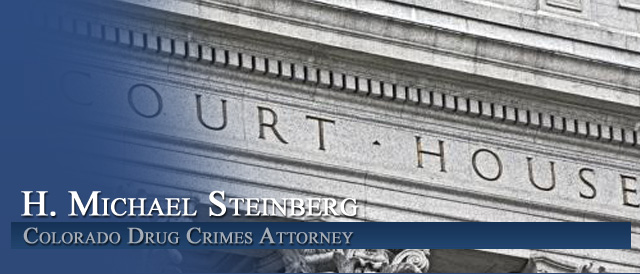




The List of Controlled Substances as Identified by the Federal Government
Provided by Colorado Criminal Defense Drug Crimes Lawyer – H. Michael Steinberg
This list describes the basic or parent chemical and do not describe the salts, isomers and salts of isomers, esters, ethers and derivatives which may be controlled substances. These lists are intended as general references and are not comprehensive listings of all controlled substances. Please note that a substance need not be listed as a controlled substance to be treated as a Schedule I substance for criminal prosecution.
A controlled substance analogue is a substance which is intended for human consumption and is structurally or pharmacologically substantially similar to or is represented as being similar to a Schedule I or Schedule II substance and is not an approved medication in the United States. (See 21 U.S.C. §802(32)(A) for the definition of a controlled substance analogue and 21 U.S.C. §813 for the schedule.)
Defined Abbreviations
2C-B 4-Bromo-2,5-dimethoxyphenethylamine
2C-T-7 2,5-Dimethoxy-4(n)-propylthiophenethylamine
BZP N-Benzylpiperazine
DMT Dimethyltryptamine
DOM 4-Methyl-2,5-dimethoxyamphetamine
GBL Gamma butyrolactone
GHB Gamma hydroxybutyric acid, gamma hydroxybutyrate, 4-hydroxybutanoic acid, sodium oxybate
LAAM Levo-alphacetylmethadol
LSD Lysergic acid diethylamide, lysergide
MDA 3,4-Methylenedioxyamphetamine
MDE 3,4-Methylenedioxy-N-ethylamphetamine
MDMA 3,4-Methylenedioxymethamphetamine
MPPP 1-Methyl-4-phenyl-4-propionoxypiperidine
P2P Phenyl-2-propanone, phenylacetone
PCC 1-Piperidinocyclohexanecarbonitrile
PCE N-Ethyl-1-phenylcyclohexylamine
PCH 1-Phenylcyclohexylamine
PCP 1-(1-Phenylcyclohexyl)piperidine, phencyclidine
PEPAP 1-(2-Phenylethyl)-4-phenyl-4-acetoxypiperidine
PHP 1-(1-Phenylcyclohexyl)pyrrolidine
SPA (-)-1-Dimethylamino-1,2-diphenylethane
TCP 1-[1-(2-Thienyl)cyclohexyl]piperidine
TCPy 1-[1-(2-Thienyl)cyclohexyl]pyrrolidine
THC Tetrahydrocannabinols
THG Tetrahydrogestrinone
Colorado Drug Crimes Defense – The Definition of Controlled Substance – The Schedules
A listing of the substances and their schedules is found in the DEA regulations, 21 C.F.R. Sections 1308.11 through 1308.15.
A controlled substance is placed in its respective schedule based on whether it has a currently accepted medical use in treatment in the United States and its relative abuse potential and likelihood of causing dependence. Some examples of controlled substances in each schedule are outlined below.
NOTE: Drugs listed in schedule I have no currently accepted medical use in treatment in the United States and, therefore, may not be prescribed, administered, or dispensed for medical use. In contrast, drugs listed in schedules II-V have some accepted medical use and may be prescribed, administered, or dispensed for medical use
Schedule I Controlled Substances
Some examples of substances listed in schedule I are: heroin, lysergic acid diethylamide (LSD), marijuana (cannabis), peyote, methaqualone, and 3,4-methylenedioxymethamphetamine (“ecstasy”).
Schedule II Controlled Substance
Substances in this schedule have a high potential for abuse which may lead to severe psychological or physical dependence.
Examples of single entity schedule II narcotics include morphine and opium. Other schedule II narcotic substances and their common name brand products include: hydromorphone (Dilaudid®), methadone (Dolophine®), meperidine (Demerol®), oxycodone (OxyContin®), and fentanyl (Sublimaze® or Duragesic®).
Examples of schedule II stimulants include: amphetamine (Dexedrine®, Adderall®), methamphetamine (Desoxyn®), and methylphenidate (Ritalin®). Other schedule II substances include: cocaine, amobarbital, glutethimide, and pentobarbital.
Schedule III Controlled Substances
Examples of schedule III narcotics include combination products containing less than 15 milligrams of hydrocodone per dosage unit (Vicodin®) and products containing not more than 90 milligrams of codeine per dosage unit (Tylenol with codeine®). Also included are buprenorphine products (Suboxone® and Subutex®) used to treat opioid addiction.
Examples of schedule III non-narcotics include benzphetamine (Didrex®), phendimetrazine, ketamine, and anabolic steroids such as oxandrolone (Oxandrin®).
Schedule IV Controlled Substancs
Substances in this schedule have a low potential for abuse relative to substances in schedule III.
An example of a schedule IV narcotic is propoxyphene (Darvon® and Darvocet-N 100®).
Other schedule IV substances include: alprazolam (Xanax®), clonazepam (Klonopin®), clorazepate (Tranxene®), diazepam (Valium®), lorazepam (Ativan®), midazolam (Versed®), temazepam (Restoril®), and triazolam (Halcion®).
Schedule V Controlled Substances
Substances in this schedule have a low potential for abuse relative to substances listed in schedule IV and consist primarily of preparations containing limited quantities of certain narcotics. These are generally used for antitussive, antidiarrheal, and analgesic purposes.
Examples include cough preparations containing not more than 200 milligrams of codeine per 100 milliliters or per 100 grams (Robitussin AC® and Phenergan with Codeine®).
Disclaimer:
Section 812 of the Controlled Substances Act (21 U.S.C. §801 et seq.) (CSA) lists substances which were controlled in 1970 when the law was enacted. Since then, approximately 160 substances have been added, removed, or transferred from one schedule to another. The current official list of controlled substances can be found in section 1308 of the most recent issue of Title 21 Code of Federal Regulations (CFR) Part 1300 to end (21 CFR §1308) and the final rules which were published in the Federal Register subsequent to the issuance of the CFR.
Other Articles of Interest:
- Comprehensive List Of Colorado Drug Crimes – Offenses
- 2011 Changes to Colorado Drug Crimes Laws: Synthetic Marijuana
- Colorado Drug Crimes – Possession of Analog – (Analogue) Drugs – A Controlled Substance?
- The Defense Of Colorado Drug Crimes Cases – Questions Your Colorado Drug Crimes Defense Lawyer Should Be Asking…
- Colorado Drug Crimes Classified By Statute, Name, and Possible Punishment












